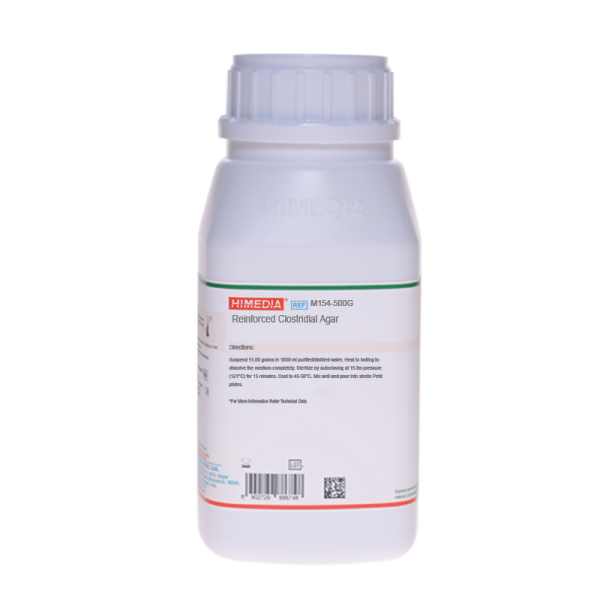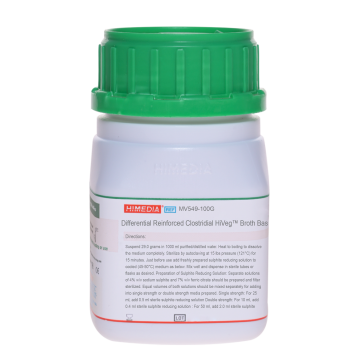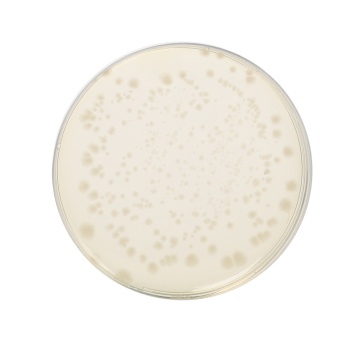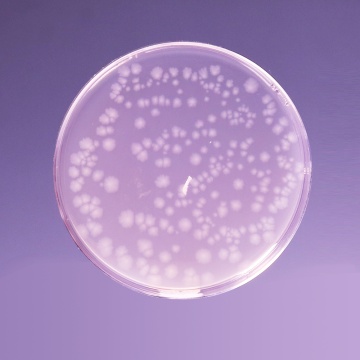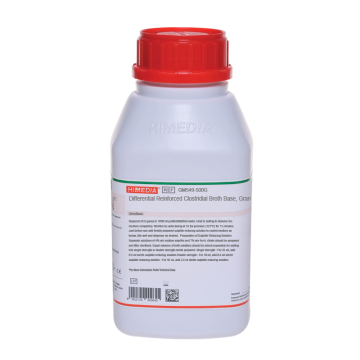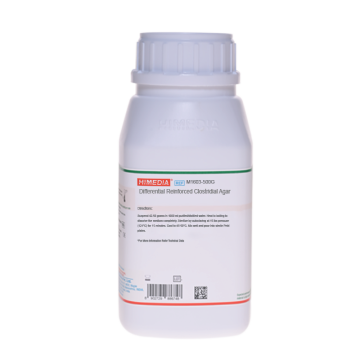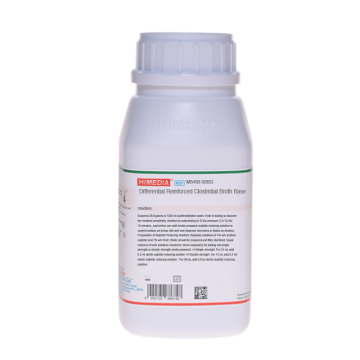 Your enquiry has been submitted
Your enquiry has been submitted
Reinforced Clostridial Agar
Intended Use
Recommended for the cultivation and enumeration of Clostridia and other anaerobes.
Composition**
| Ingredients | g / L |
|---|---|
| Tryptone | 10.000 |
| HM peptone B # | 10.000 |
| Yeast extract | 3.000 |
| Dextrose (Glucose) | 5.000 |
| Sodium chloride | 5.000 |
| Sodium acetate | 3.000 |
| Starch, soluble | 1.000 |
| L-Cysteine hydrochloride | 0.500 |
| Agar | 13.500 |
Final pH ( at 25°C) 6.8±0.2
**Formula adjusted, standardized to suit performance parameters
# Equivalent to Beef extract
Directions
Suspend 51.00 grams in 1000 ml purified/distilled water. Heat to boiling to dissolve the medium completely. Sterilize by autoclaving at 15 lbs pressure (121°C) for 15 minutes. Cool to 45-50°C. Mix well and pour into sterile Petri plates.
Principle And Interpretation
Hirsch and Grinstead formulated Semisolid Reinforced Clostridial Medium and found that clostridia from small amount of samples could be grown well on this medium with higher viable cell counts (1). This medium can also be used for growing anaerobic and facultative bacteria (2). Barnes et al used a solid (agar) version of the medium (2) to develop vegetative cells in assays of Clostridium perfringens. Reinforced Clostridial Medium was used in the enumeration of clostridia from food (3). Reinforced Clostridial Agar contains tryptone and HM peptone B as sources of carbon, nitrogen, vitamins and minerals. Yeast extract supplies B-complex vitamins which stimulate bacterial growth. Dextrose is the carbohydrate source. Sodium chloride maintains the osmotic balance. In low concentrations, soluble starch detoxifies metabolic byproducts. Cysteine hydrochloride is the reducing agent. Sodium acetate acts as a buffer. This medium can be made selective by addition of 15-20 mg polymyxin B per litre of media (3).
Material to be examined is homogenized in a stomacher, and dilutions are prepared. For enumeration, pour plate technique is employed. Incubate anaerobically. If tubes are used, they are covered with sealing Anaerobic Agar immediately after the Reinforced Clostridium Medium has solidified.
Type of specimen
Food and dairy samples.
Specimen Collection and Handling
For food and dairy samples, follow appropriate techniques for sample collection and processing as per guidelines (4,5,6). After use, contaminated materials must be sterilized by autoclaving before discarding.
Warning and Precautions
Read the label before opening the container. Wear protective gloves/protective clothing/eye protection/ face protection. Follow good microbiological lab practices while handling specimens and culture. Standard precautions as per established guidelines should be followed while handling specimens. Safety guidelines may be referred in individual safety data sheets.
Limitations
- Further subculturing is required for confirmatory tests.
Performance and Evaluation
Performance of the medium is expected when used as per the direction on the label within the expiry period when stored at recommended temperature.
Quality Control
Appearance: Cream to yellow homogeneous free flowing powder
Gelling: Firm, comparable with 1.35% Agar gel.
Colour and Clarity of prepared medium: Light yellow coloured clear to slightly opalescent gel forms in Petri plates
Reaction: Reaction of 5.1% w/v aqueous solution at 25°C. pH : 6.8±0.2
pH: 6.60-7.00
Cultural Response: Cultural characteristics observed in an anaerobic atmosphere after an incubation at 35 - 37°C for 40 - 48 hours.
| Organism | Inoculum (CFU) | Growth | Recovery |
|---|---|---|---|
| Bacteroides fragilis ATCC 23745 | 50-100 | good - luxuriant | >=50% |
| ^Phocaeicola vulgatus ATCC 8482 | 50-100 | good - luxuriant | >=50% |
| Clostridium butyricum ATCC 13732 | 50-100 | good - luxuriant | >=50% |
| Clostridium perfringens ATCC 13124 (00007*) | 50-100 | good - luxuriant | >=50% |
Key: (*) Corresponding WDCM numbers
^ Formerly known as Bacteroides vulgatus
Storage and Shelf Life
Store between 10-30°C in a tightly closed container and the prepared medium at 20-30°C. Use before expiry date on the label. On opening, product should be properly stored dry, after tightly capping the bottle in order to prevent lump formation due to the hygroscopic nature of the product. Improper storage of the product may lead to lump formation. Store in dry ventilated area protected from extremes of temperature and sources of ignition. Seal the container tightly after use. Product performance is best if used within stated expiry period.
Disposal
User must ensure safe disposal by autoclaving and/or incineration of used or unusable preparations of this product. Follow established laboratory procedures in disposing of infectious materials and material that comes into contact with sample must be decontaminated and disposed of in accordance with current laboratory techniques (7,8).
Reference
- Hirsch A. and Grinstead C., 1954, J. Dairy Res. 21:10.
- Barnes E. M., Despaul J. E. and Ingram M., 1963. J. Appl. Bacteriol. 26:41
- Barnes E. M. and Ingram J. E., 1956. J. Appl. Bacteriol. 19:11
- Salfinger Y., and Tortorello M.L. Fifth (Ed.), 2015, Compendium of Methods for the Microbiological Examination of Foods, 5th Ed., American Public Health Association, Washington, D.C.
- Wehr H. M. and Frank J. H., 2004, Standard Methods for the Microbiological Examination of Dairy Products, 17th Ed., APHA Inc., Washington, D.C.
- American Public Health Association, Standard Methods for the Examination of Dairy Products, 1978, 14th Ed., Washington D.C.
- Isenberg, H.D. Clinical Microbiology Procedures Handbook 2nd Edition.
- Jorgensen, J.H., Pfaller, M.A., Carroll, K.C., Funke, G., Landry, M.L., Richter, S.S and Warnock., D.W. (2015) Manual of Clinical Microbiology, 11th Edition. Vol. 1.
| Product Name | Reinforced Clostridial Agar |
|---|---|
| SKU | M154 |
| Product Type | Regular |
| Physical Form | Powder |
| Origin | Animal |
| Packaging type | HDPE |
| References | 1.American Public Health Association, Standard Methods for the Examination of Dairy Products, 1978, 14th Ed., Washington D.C. 2.Barnes E. M., Despaul J. E. and Ingram M., 196 3.J. Appl. Bacteriol. 26:41 3.Barnes E. M. and Ingram J. E., 195 6.J. Appl. Bacteriol. 19:11 4.Hirsch A. and Grinstead C., 1954, J. Dairy Res. 21:10 5.Isenberg, H.D. Clinical Microbiology Procedures Handbook 2nd Edition. 6.Jorgensen,J.H., Pfaller, M.A., Carroll, K.C., Funke, G., Landry, M.L., Richter, S.S and Warnock.,D.W. (2015) Manual of Clinical Microbiology, 11th Edition. Vol. 1. 7.Salfinger Y., and Tortorello M.L. Fifth (Ed.),2015, Compendium of Methods for the Microbiological Examination of Foods, 5th Ed., American Public Health Association, Washington, D.C. 8.Wehr H. M. and Frank J. H., 2004, Standard Methods for the Microbiological Examination of Dairy Products, 17th Ed.,APHA Inc., Washington, D.C. |
| Customized Product Available | No |



